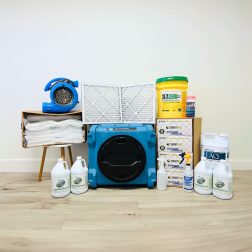No products in the cart.
Mold Resources
Understanding how to remediate mold step by step will help protect you from unwanted exposures. The longer the colony exists inside, the more particles it releases into the air you breathe every time you step in the door.
Key Detail: How to remediate mold step by step includes fixing the source that led to the issue and then eliminating the growing colony, roots, dead particles, and any other contaminants hanging around as well. If the source that led to the contamination isn’t addressed, the conditions for growth are still there, allowing the problem to come right back. Should the roots of the microbial growth be left behind, the colony can come right back. High levels of contaminants like mycotoxins and bacteria left behind can lead to continued exposure. Each scenario does not lead to a situation that supports your health.
The protocol you use will depend on the surface type.
Surface types include:
- Porous: liquid absorbs into them, such as clothing, lampshades, and carpet
- Semi-porous: some liquid pools on top, and some seeps into it, such as unsealed wood, leather furniture, and some plastic
- Non-porous: liquid pools on top of them, such as finished wood, sealed countertops, and glass
How to Remediate Mold Step by Step for Surface Type
Non-Porous
These surfaces are the most straightforward and successful to remediate, so we should opt for them as much as possible in our homes. Particles can’t travel deep into the surface, so using the right products and techniques can pull them from the surface and eliminate them entirely.
For non-porous surfaces:
- Spray a botanical cleaner on the surface (I recommend Benefect Decon 30)
- Allow this to sit for 30 seconds, then wipe with a microfiber towel. Microfiber towels are 100 times more effective at wiping away small particles than regular rags.
- Repeat the process at least three times to ensure all contaminants are removed, including mycotoxins and bacteria, flipping the towel to a new side each time
- Allow the surface to dry completely
Semi-Porous
For semi-porous surfaces, it’s a little more tricky because the roots of the mold can grow into the surface itself and be difficult to remove completely.
To remediate semi-porous surfaces:
- Use a HEPA vacuum and thoroughly go over the surface:
- Apply 8% hydrogen peroxide and allow this to dry
- Use an abrasive method such as sanding or wire brushing to go over the surface (if possible)
- HEPA vacuum the surface thoroughly once again
- Spray a botanical cleaner such as Benefect Decon 30 and allow it to sit for 10 seconds
- Wipe with a microfiber towel and then allow this to dry
- Complete the spray, wipe down, and drying process once more using a new side of the microfiber towel
- Dry encapsulate/seal the surface (if possible)
- When dry, wipe again with a microfiber towel
Keep a close eye on the surface to see if the mold returns. If it returns quickly, the colony could have permeated deep beneath the surface, or there could be a more significant problem elsewhere in the home. Either way, you can attempt the process outlined above for how to remediate mold step by step, but it may be time to call in the professionals.
Porous
For porous surfaces like drywall, remove and replace the material. The contamination can exist deep within the fibers and be impossible to remove altogether. Discarding and replacing porous surfaces/items like clothing is also best. If you want to attempt to remediate this surface, use a HEPA vacuum cleaner thoroughly on the surface and throw it in the wash with a botanical laundry additive (I prefer EC3).
Pro Tip: When you’re remediating surfaces, particles will become airborne during the removal process. Knowing how to remediate mold step by step is important, but it's not the only thing to consider. Setting up proper engineering controls, wearing personal protective equipment, and creating a containment area should be included to help protect you and your home from these particles. Make sure to also deep clean to eliminate these particles and prevent them from spreading to other areas of the building and lowering your indoor air quality.
Get Started on How to Remediate Mold Step by Step
Take out the guesswork of choosing the right materials by investing in the HomeCleanse DIY. It contains all the equipment and materials we use to remediate your home, plus consultation and support with us on how to do it yourself safely.
Showing the single result
When In Doubt
Only work on areas under 10 square feet. Contacting an expert beforehand can give you a full breakdown of how to address the issue properly. If the issue is larger than 10 square feet, call in the professionals so you have peace of mind that you’re on track for success.
Still Have Questions?
A member of our team is here to help! Click on “Get Started ➤” below to book a consultation with a member of the HOMECLEANSE team. We have a few quick questions that will help us put together a roadmap to solve or prevent all of your mold problems.
Two minutes of your time could lead to better health for you and your family.

